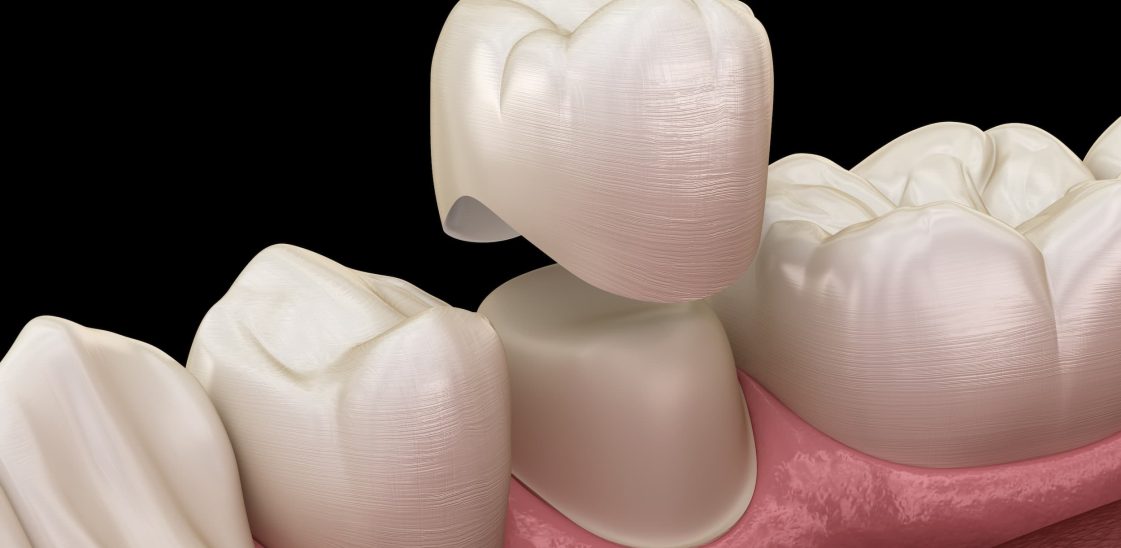
What is a crown on a tooth?
Dental crowns are a form of treatment that your dentist may recommend to you in certain circumstances. It’s always your choice whether or not to have a dental crown fitted, so it’s important that you understand what a dental crown is and what it’s for before you make your final decision.
In this blog, we’ll explore what a dental crown is and how it works to protect and support your teeth.
What is a dental crown?
A dental crown or cap is a type of treatment that involves the addition of a false partial tooth structure to your existing tooth. There are a number of different reasons why a crown might be needed, including damage or decay to the tooth.[1] You can also have a dental crown fitted simply to improve the appearance of your tooth – for example if you have had fillings on your front teeth that are easily seen.[2]
Dental crowns can be made out of ceramic, metal or porcelain fused onto metal. They’re fixed into your mouth, so they cannot be taken out the way you might take out dentures overnight. As a permanent fixture on your teeth, dental crowns can help to protect your teeth against sensitivity.[1]
However, your dentist will usually try other, less permanent solutions first to see if the problem can be solved more easily. For instance, your dentist might recommend using mouth guards such as DenTek Maximum Protection Dental Guards to shield your teeth against bruxism (teeth grinding) at night, which can help to alleviate sensitivity and damage caused by teeth grinding and help to reduce the risk of needing a dental crown or other major treatments in the future.[3]
How does a crown tooth work?
Crown teeth are essentially a hollowed out denture that fits over your existing tooth. Made out of durable materials like ceramic or metal, they take the brunt of the wear and tear your teeth usually endure, helping to keep your teeth protected inside. In addition, they can improve your eating experience if you have damaged or decayed teeth, particularly when the shape or structure of your tooth has been affected.[2]
In order to have a crown fitted onto your tooth, the existing tooth will need to be drilled down. This makes it smaller and changes its shape, making it easier to fit the crown over the tooth securely. However, this also means that the procedure takes time and impacts the shape of the existing tooth permanently – so your dentist will try other, more temporary solutions first.[1]
It’s also true that it takes time for your new crowns to be made. This is to ensure that it fits well in your mouth and aligns with the rest of your teeth to create a harmonious surface – otherwise you might develop other dental problems caused by the ill-fitting crown. The time factor is another reason why people may prefer to try other solutions first before opting to have a crown fitted.[1] Additionally, there are some situations where a crown wouldn’t be suitable, in which case your dentist will suggest appropriate alternatives.[2]
If you don’t already need a crown, there are plenty of things you can do to keep your teeth healthy and protected so you’re less likely to need one in the future. One thing you can do is to use interdental cleaning tools such as Dentek’s Triple Clean Floss Picks to remove bacteria and food particles from the spaces between your teeth which are typically hard to reach with a toothbrush alone. Doing so can help to reduce your risk of needing dental treatment, but it’s also important to regularly visit your dentist for a check-up.[4]
Although it’s best to look after your teeth as best you can to avoid ever needing a dental crown, they can be a good solution to help protect your teeth and resolve issues caused by poor dental hygiene in the past. If you think a dental crown could be helpful in your case, you should speak to your dentist to learn more about the procedure. They might also suggest other solutions that may be better suited to your teeth.
Resources:
[1] – https://www.nhs.uk/live-well/healthy-teeth-and-gums/dental-treatments/
[2] – https://flipbooks.leedsth.nhs.uk/LN004338.pdf
[3] – https://www.nhs.uk/conditions/teeth-grinding/
[4] – https://www.nhs.uk/live-well/healthy-teeth-and-gums/take-care-of-your-teeth-and-gums/




